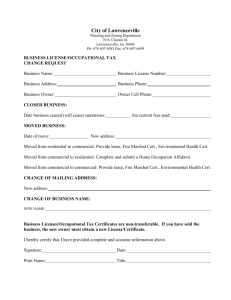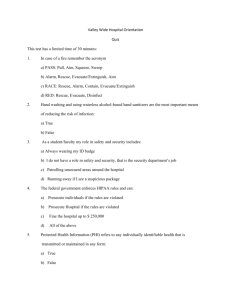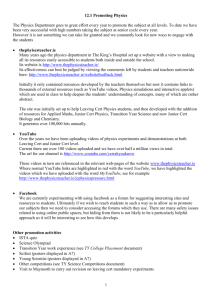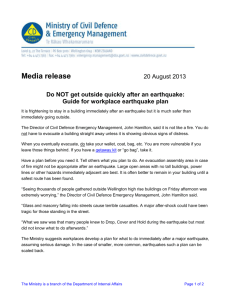Building Marshal Review
advertisement
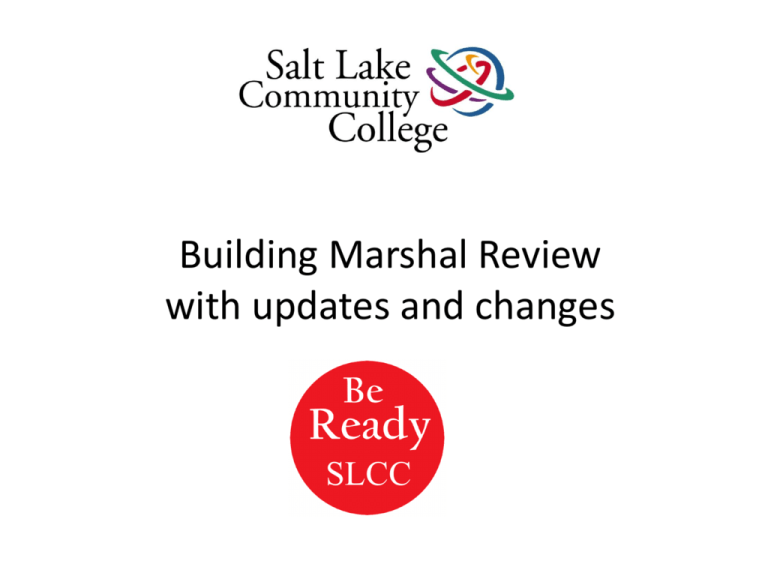
Building Marshal Review with updates and changes SLCC General Emergency Guidelines • Do the following during an emergency: • Be familiar with, and use, the SLCC Emergency Procedures Handbook. • If you are on campus turn on CERT radio to Channel 1. • Report emergencies to public safety at 801-957-3800 • Call Department of Public Safety-Emergency Management @801-957-4963. General Emergency Guidelines (Continued) • If DPS- EM does not answer contact 9-1-1. • Evacuate buildings immediately, or at the request of authorities, upon hearing an alarm, or when remaining becomes life threatening. • Please have Faculty and Student go to their assembly areas. (for accountability) • Keep a CERT Bag/ BLDG Marshal’s bag nearby, with emergency items ready to go. • Know the location of all exits from your area. • Every SLCC building has a Building Marshal and a CERT Team. Know who all of the building marshals are. If an emergency is confined to your building, other building marshals may help. (SEE APPENDIX A) • Create a call down list of personnel willing to support your Building Marshal responsibilities. Please keep current. Before you leave your Area... •Check Staff/Students to ensure safety •Inspect area for damage •Inspect utilities and secure as needed •Call contacts at _________ •Get Area disaster supplies EARTHQUAKE PREPAREDNESS • Identify areas in your building that may be a danger of falling objects. • Have Facilities secure fixtures such as lights, cabinets, bookcases and heavy objects that may come loose or fall during an earthquake. Do not hang plants in heavy pots that could swing free of hooks. • If you feel it is necessary, have Facilities check the electrical wiring and gas connections to equipment. Defective electrical connections or inflexible gas connections are dangerous during an earthquake. • Any shutoff of main valves or switches for electrical, gas or water will be handled by Facilities. • Hold drills so that each member of your CERT team knows what to do during an earthquake. EARTHQUAKE PREPAREDNESS (continued) • Make sure your CERT bag is stocked and ready for use. Your CERT bag is not the office first aid kit. The items in your bag should be used for emergencies only. • (SEE APPENDIX B FOR CERT BAG SUPPLIES LIST) • After an earthquake, make sure everyone is all right. Don’t move the seriously injured unless they are still in danger. Follow appropriate CERT training requirements. • Do not use telephones unless there is a severe injury. Ensure that all telephones are in their cradles. Telephones may or may not be operating after an earthquake. • Leave buildings that have been damaged until a safety assessment can be made. • Stay at work (assist if needed) until you know it is safe to leave. Evaluate your situation: Can you get home? Is it the best place to go? Listen to the radio, but make sure the reports are confirmed before you react to the news. FIRE PREPAREDNESS • Be involved in a fire prevention program in your building. Make periodic inspections of your building for fire hazards. • In the case of a fire and if the alarm does not sound, warn the building occupants to evacuate after you pull the alarm. • If an alarm sounds, assist in the orderly evacuation of your building. After the alarm has been sounded, if it is safe, you should go to the fire alarm panel on the main floor with your CERT radio to give instructions to responding personnel. • Members of your CERT team and Floor Monitors should be involved in periodic team drills and accounting for the people in your building during a fire. • Be aware that if an alarm sounds, the fire department will be automatically notified. • Be prepared to give directions and additional information, if necessary, to responding personnel. • Know the location and monitor the serviceability of all fire extinguishers in your building. POWER FAILURE PREPAREDNESS • Establish and maintain contact with the appropriate Facilities personnel. • Keep a listing of all items shut down during the power failure. Provide this list to Facilities prior to the building being re-energized. • All buildings on the SLCC Campus’ have backup power for some essential services. These systems come on line automatically. In the event of long term power outages the telephone system will operate for approximately 2 hours on battery backup power. • See if anyone is trapped in elevators. Advise them not to try and get out of the elevator. Contact Facilities to report this. 801 -957-3911 • In areas with no natural lighting, place flashlights where they may help guide occupants to the nearest exit. WATER MAIN BREAK PREPARED • Contact Facilities for help with getting the appropriate valves closed. Facilities prefers that they handle all valves and have assured us of a 5 minute response time 24 hours a day. 801-957-3911 • Identify any equipment in your building which may be affected by a water main break and take appropriate action NATURAL GAS AND PROPANE LEAK PREPAREDNESS • Learn the following characteristics of flammable gases: – Petroleum gases (bottled propane) are heavier than air and will seek the lowest level. – Natural gas: – Lighter than air and will rise – Usually odorless but usually has an odorant added to make it more noticeable. – Flammable at a concentration of 5% in air. It can be ignited by any source of a spark or a flame. • When a gas leak is noticed notify Campus Police (Utah Highway Patrol). Always evacuate first and make notification from another location. 801-957-3800 • Do not operate any electrical equipment or switches (even light switches or a fire alarm) • When you evacuate a building always move at twice the distance of the height of the building to escape any flying glass. • Do not attempt to close any natural gas valves. This will be accomplished by Facilities. • Do not attempt to extinguish a natural gas fire. Let it burn. ELEVATOR MALFUNCTION PREPAREDNESS • Become familiar with the elevators in your building and know what will affect their operation. • Monitor the maintenance on your elevators and see that their emergency telephones and instructions remain operational. • If people become stranded in an elevator: • Determine the floor on which they are stalled. If they have an emergency phone tell them to use it. • Tell the stranded individuals that help is on the way and they and they will be rescued safely. • Report this situation to Facilities as soon as possible 801-957-3911 HAZARDOUS MATERIALS INCIDENT PREPAREDNESS • Become familiar with the hazardous materials in your building and where they are stored. You should be able to get a list for the appropriate Division Chairs or Facilities personnel that store these materials in your building. Keep this list in a location where you have easy access and can carry it with you if you have to evacuate the building. (SEE APPENDIX C) • If you have an incident involving hazardous materials: – Evacuate any involved individuals from the area if you can do so without exposing yourself to unnecessary risk • – Contact Public Safety and Environmental Health and Safety and report as much information concerning what and how much has been released 801-957-3800 and 801-957-4902 • Do not walk into or touch any spilled material. If your shoes do get contaminated don’t leave the area with your shoes on. It will contaminate other areas. • Avoid inhalation of gases, fumes, and smoke, even if no hazardous material is involved. • When responders arrive (Environmental Health and Safety or Fire Department) provide them with your list of hazardous materials in your building. • Do not wash any of these materials into drains. DISASTER RESPONSIBILITIES (Emergency & Events) • One of the Building Marshal’s primary responsibilities during a disaster is to provide a communications link between Facilities, Department of Public Safety and any responding personnel. • In the event of a disaster each Building Marshal should report to the Campus Emergency Operations Center either in person or by their CERT radio (Channel 1) for instructions. • Information to be collected and passed on to the Emergency Operations Center will include: (assembly areas for accountability) – Number of individuals still in your building. – Number of individuals still missing. – Number of injuries and a summary of these injuries. – Any immediate first aid required. – Estimate of damage to the building and contents. BUILDING EVACUATION PLANS • This section provides an area for building evacuation plans. These plans should contain a map for each floor of your building. Each floor plan should include the evacuation routes from each room on each floor. The plan for the main floor will indicate the outside assembly area for your building. • Get a drawing of your building on line. This should be inserted into your booklet. (if you cannot find one contact Facilities) BLDG Marshal Bag Please keep your Bag updated. Please check items regularly to ensure operational needs during an emergency HAZMAT List Please review your buildings for Hazardous Materials. Please make note of them and location and how many to help first responders.
